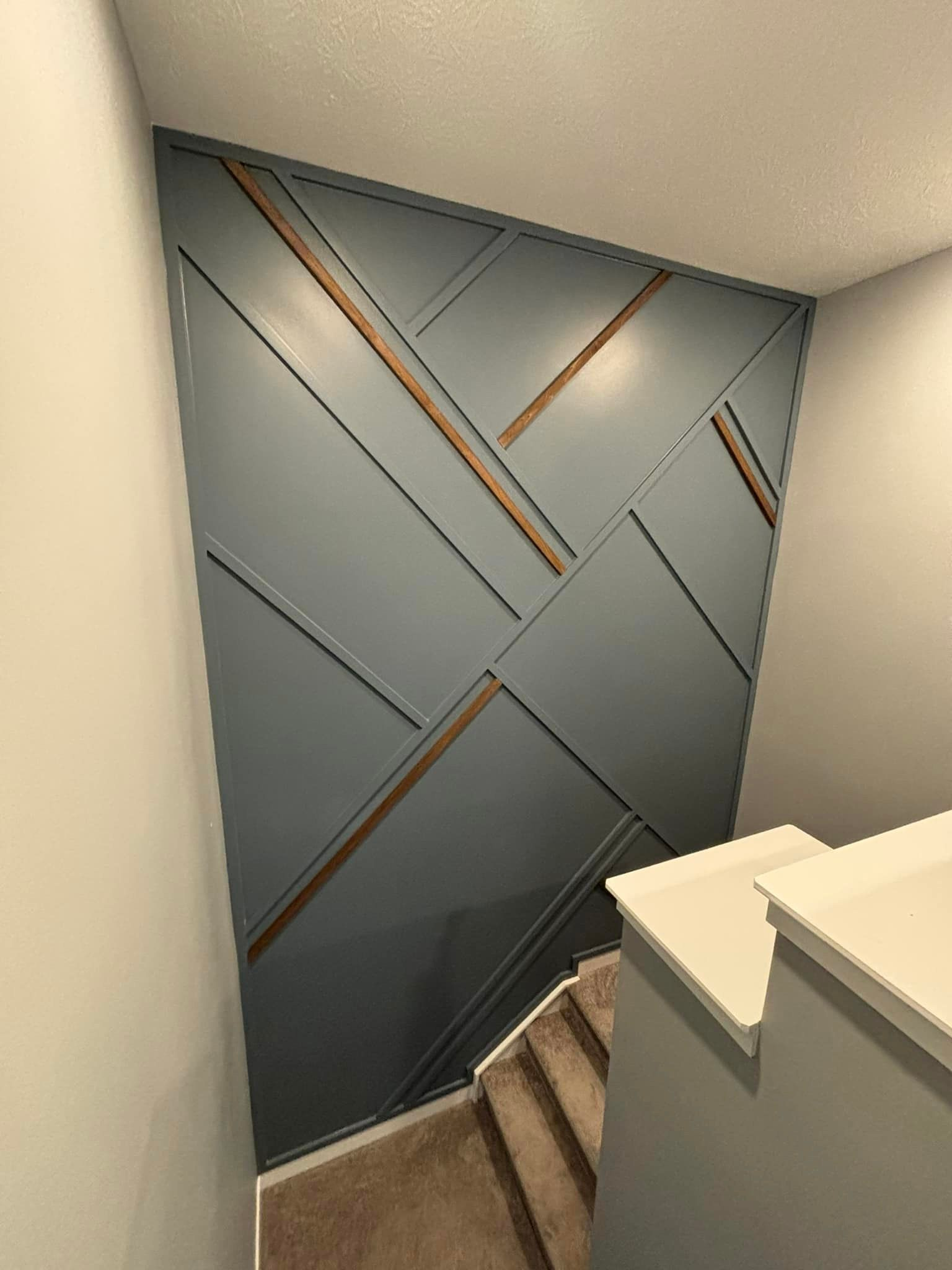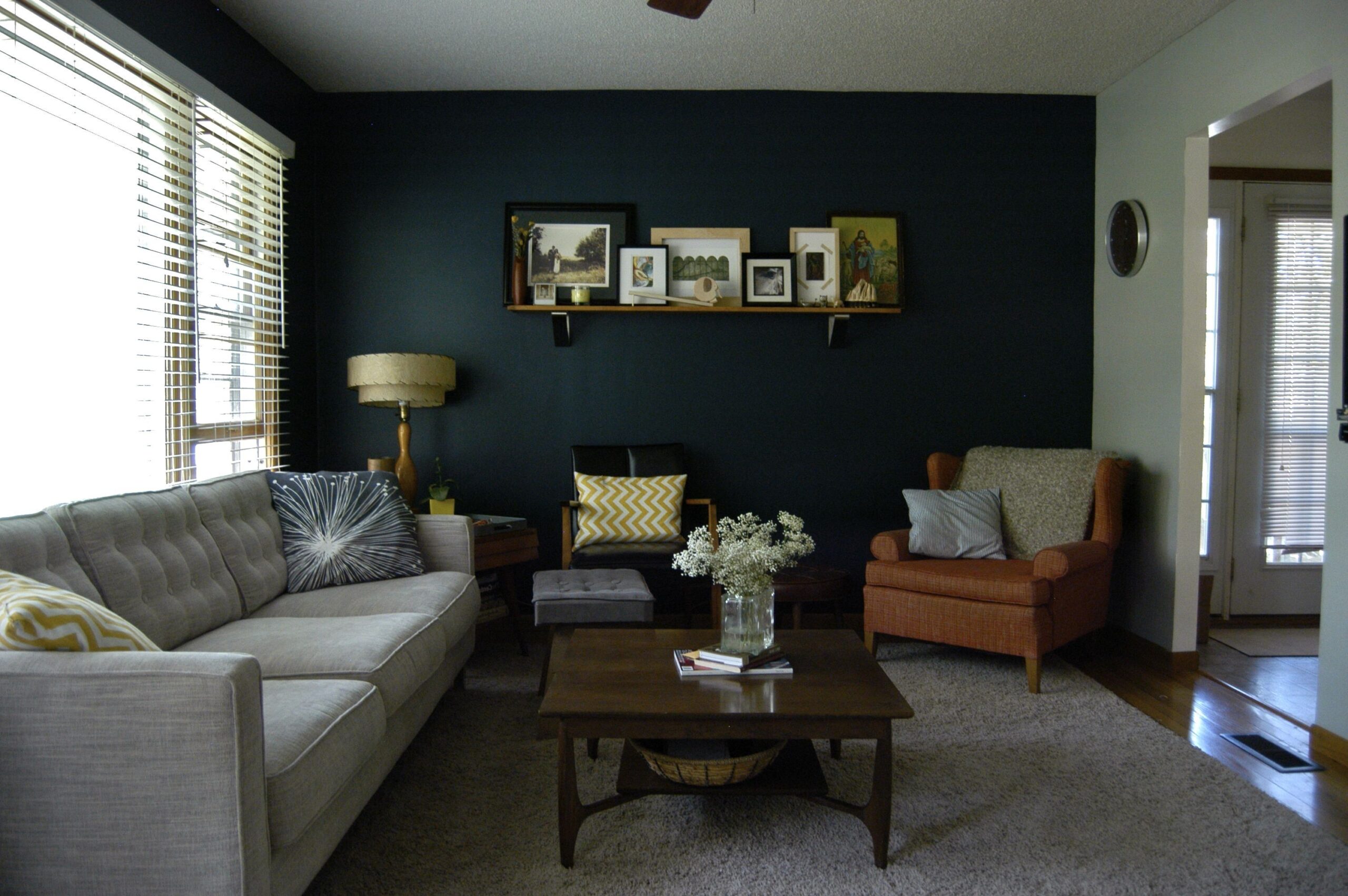Accent walls have become a powerful tool in interior design, offering a way to transform spaces with minimal effort and maximum impact. These strategic design elements can dramatically alter the perception of a room, adding depth, character, and visual interest. At Radford Woodworks, we’ve seen how well-executed accent walls can turn ordinary rooms into extraordinary spaces.
The Role of Focal Points in Design
Every well-designed room benefits from a focal point – an area that naturally draws the eye and anchors the space. Accent walls serve this purpose beautifully, creating a visual hierarchy within a room. They can highlight architectural features, complement furniture arrangements, or stand alone as works of art in their own right.
Selecting the Ideal Wall
Choosing the right wall for your accent is a critical decision. Typically, the best candidate is the wall you see first when entering a room. In bedrooms, the wall behind the headboard often makes an ideal accent wall. For living rooms, consider the wall where your main seating area faces or the one that houses the fireplace or TV.
When selecting your accent wall, consider the room’s shape and size. In a long, narrow room, an accent wall at the far end can make the space feel more proportionate. In a large, open area, an accent wall can help define separate functional zones.
Color and Contrast
One of the simplest ways to create an accent wall is through color. Bold, contrasting colors can make a strong statement and completely change the feel of a room. When choosing a color, consider the existing palette in your space. The accent color should complement your current decor.
Dark colors, like deep blues or charcoal grays, can add sophistication and coziness to a room. They work particularly well in spaces where you want to create a sense of intimacy, such as dining rooms or bedrooms. Dark colors can also make a room feel smaller, which can be beneficial in overly large spaces that lack coziness.
Lighter, brighter colors can make a space feel more open and energetic. These work well in smaller rooms or areas where you want to create a lively atmosphere, like kitchens or home offices. Bright colors can also be used to highlight architectural features or to create a cheerful, welcoming environment.
When working with color, consider the psychology behind different hues. Warm colors like reds, oranges, and yellows can create a sense of energy and excitement. Cool colors like blues, greens, and purples tend to have a calming effect. The right color choice can significantly influence the mood and function of a room.
Texture and Dimension
Paint isn’t the only way to create an accent wall. Adding texture can bring a new dimension to your space. At Radford Woodworks, we specialize in creating custom wood accent walls that add warmth and character to any room.
Wood paneling, whether in a traditional style or a more modern geometric pattern, can create a rich, textured look. The natural grain and color variations in wood add depth and interest that paint alone can’t achieve. Different wood species offer various colors and grain patterns, allowing for customization to suit any design style.
Reclaimed wood is particularly popular for accent walls. It brings a sense of history and character to a space, with each plank telling its own story. The weathered look of reclaimed wood can add rustic charm to modern spaces or enhance the authenticity of traditional designs.
For a more contemporary look, consider using wood in unexpected ways. Geometric patterns created with wood pieces can form a striking accent wall. This could involve herringbone or chevron patterns, or even more complex designs that incorporate different wood types or finishes.
Stone or brick veneer can bring a touch of rustic charm or industrial chic to your space. These materials work particularly well in living rooms or as a backdrop for fireplaces. They can add a sense of permanence and solidity to a room, grounding the space and creating a strong visual anchor.
Textured wallpapers or 3D wall panels offer another way to add dimension to your accent wall. These can range from subtle, organic textures to bold, geometric patterns. Textured walls catch light in interesting ways, creating shadows and highlights that change throughout the day, adding visual interest to your space.
Wallpaper and Murals
Wallpaper has made a strong comeback in recent years, offering endless possibilities for accent walls. From subtle textures to bold patterns, wallpaper can add personality and style to any room.
Large-scale patterns or murals can create a dramatic effect, turning your accent wall into a piece of art. These work particularly well in dining rooms or entryways, where they can make a strong first impression. A mural can transport you to another place, create an illusion of expanded space, or simply provide a conversation starter for guests.
Geometric patterns are a popular choice for modern interiors. They can add a sense of movement and energy to a space, making it feel more dynamic. Geometric wallpapers can range from simple, repeating patterns to complex designs that create optical illusions or 3D effects.
Nature-inspired wallpapers, featuring botanical prints or landscapes, can bring a sense of the outdoors inside. These can be particularly effective in urban environments where access to nature might be limited.
Abstract or artistic wallpapers can serve as a backdrop for minimalist decor, allowing the wall itself to be the main decorative element in a room. This can be an effective way to incorporate color and pattern without cluttering a space with additional decorative items.
Functional Accent Walls
Accent walls don’t have to be purely decorative. They can serve practical purposes as well. Built-in shelving or a gallery wall can create visual interest while providing storage or display space.
A custom-built shelving unit can be designed to fit perfectly on your accent wall, providing both a decorative element and functional storage. This can be particularly useful in home offices, living rooms, or children’s bedrooms. The shelves themselves can be part of the design, with varying sizes and arrangements creating an artistic display even before books or objects are added.
Gallery walls allow you to display a collection of artwork or photographs in a cohesive way. The arrangement of frames becomes part of the design, and the wall can easily be updated by changing out the contents of the frames.
A chalkboard or magnetic wall in a kitchen or home office can be both stylish and functional, providing a space for notes, lists, or children’s artwork. These interactive walls can become a focal point of family activity, changing and evolving over time.
In a home gym or yoga studio, a mirrored accent wall can make the space feel larger while serving a practical purpose. Similarly, in a craft room or workshop, an accent wall could incorporate a pegboard for tool storage, combining function with visual interest.
Lighting as an Accent
Incorporating lighting into your accent wall can add another layer of drama and interest. Backlit panels, LED strips, or strategically placed sconces can highlight textures and create ambiance.
In bedrooms or living rooms, a wall of soft, glowing light can create a cozy, intimate atmosphere. This could be achieved through a backlit headboard in a bedroom or a series of wall sconces in a living area. The warm glow of these lights can make a space feel inviting and relaxing.
In dining rooms or entertainment spaces, more dramatic lighting effects can set the mood for gatherings and parties. Color-changing LED strips can allow you to adjust the atmosphere of the room to suit different occasions.
Backlighting translucent materials like onyx or acrylic panels can create a stunning visual effect. The light brings out the natural patterns in the material, creating a one-of-a-kind accent wall that changes character as the light changes.
For a subtler effect, consider using grazing lights. These are positioned to shine down or across a textured surface, emphasizing the texture by creating shadows. This technique works particularly well with stone or heavily textured wood accent walls.
Mixing Materials
For a truly unique accent wall, consider mixing materials. A combination of wood and metal, or stone and glass, can create a striking visual effect. This approach works particularly well in modern or industrial-style interiors.
At Radford Woodworks, we’ve created accent walls that combine reclaimed wood with sleek metal accents, creating a perfect balance of rustic and contemporary styles. The contrast between the warm, organic feel of wood and the cool, sleek appearance of metal can be visually striking.
Glass elements can be incorporated into accent walls to add sparkle and reflect light. This could be in the form of mirrored panels interspersed with wood or stone, or decorative glass tiles used as accents within a larger design.
Fabric can also be used in combination with harder materials to add softness and acoustic benefits to an accent wall. Upholstered panels can be interspersed with wood or metal elements to create a multi-dimensional design.
Accent Walls in Different Rooms
Each room in your home presents unique opportunities for accent walls:
Living Rooms: This is where you can make a bold statement. Large-scale patterns, rich colors, or textured materials can create a wow factor. A fireplace wall is often a natural choice for an accent, but consider other options like the wall behind your main seating area or the largest unbroken wall in the room.
Bedrooms: Softer, more soothing designs work well here. Consider a wall of subtle wallpaper behind the bed or warm wood paneling. In a master bedroom, an accent wall can create a sense of luxury and serve as a backdrop for a stylish headboard.
Kitchens: Practical yet stylish options like a tiled backsplash that extends to the ceiling can serve as an accent wall. In an open-plan kitchen, an accent wall can help define the space and separate it visually from adjacent living areas.
Home Offices: Inspirational murals or functional chalkboard walls can enhance productivity and creativity. An accent wall in a home office can also serve as a backdrop for video calls, helping to create a professional appearance.
Bathrooms: Waterproof materials like tiles in interesting patterns can create a spa-like atmosphere. An accent wall in a bathroom can make the space feel larger and more luxurious.
Dining Rooms: Bold wallpapers or rich, deep colors can create an intimate atmosphere perfect for entertaining. An accent wall in a dining room can serve as a backdrop for a sideboard or bar area.
Entryways: Make a strong first impression with a dramatic accent wall. This sets the tone for the rest of your home and can be a place to display art or create a functional space with hooks and storage.
Considerations for Success
When planning your accent wall, keep these factors in mind:
Scale: Ensure the design of your accent wall fits the scale of your room. Large patterns can overwhelm small spaces, while subtle designs might get lost in larger rooms. Consider the size of the wall itself – a large, unbroken wall can handle bolder designs than a wall with multiple windows or doors.
Balance: Your accent wall should complement the rest of your decor, not fight with it. Consider the colors and styles already present in your space. An accent wall should enhance the overall design, not detract from it.
Lighting: Natural and artificial lighting can significantly affect how your accent wall looks. Test colors and materials under different lighting conditions before making a final decision. Consider how the light changes in the room throughout the day and how this will impact your accent wall.
Longevity: While trends can be fun, consider how long you’ll be happy with your choice. Classic materials and timeless designs often have more staying power. If you enjoy changing your decor frequently, consider an accent wall that can be easily updated, like a painted wall or a gallery wall.
Functionality: Think about how the room is used and choose materials and designs that are appropriate. High-traffic areas might benefit from more durable materials, while bedrooms can accommodate softer, more delicate designs.
Architecture: Work with the existing architecture of your space. Use an accent wall to highlight attractive features or to downplay less desirable elements.
The Impact of Accent Walls
A thoughtfully designed accent wall can significantly transform a space, offering multiple benefits that go beyond mere aesthetics. These walls have the power to alter spatial perceptions, making rooms appear larger or changing their perceived shape. In bland or boxy areas, they introduce warmth and character, breathing life into otherwise unremarkable spaces.
Accent walls serve as a canvas for personal expression, allowing homeowners to showcase their unique style and creativity. This personalization not only enhances the living experience but can also potentially increase a home’s perceived value. In open-plan layouts, these walls play a crucial role in defining distinct areas without the need for physical barriers, maintaining an open feel while creating visual separation.
From a practical standpoint, accent walls provide natural focal points for furniture arrangement, guiding the flow and organization of a room. They can also improve a space’s acoustic properties, particularly when textured materials are used, helping to reduce echo and create a more comfortable auditory environment. By combining these functional and aesthetic benefits, accent walls become powerful tools in home design, capable of transforming ordinary rooms into extraordinary living spaces.
Crafting Your Unique Accent Wall

At Radford Woodworks, we believe in the transformative power of thoughtful design. An accent wall is more than just a decorative feature; it’s a way to express your personality and create a space that truly feels like home.
Our approach to creating accent walls involves a thorough consultation process. We take the time to understand your style preferences, the function of the room, and the overall design scheme of your home. This allows us to create custom solutions that not only look beautiful but also enhance the way you live in your space.
We specialize in wood accent walls, leveraging our woodworking skills to create unique, high-quality features. From selecting the perfect wood species to designing custom patterns, we ensure that each accent wall we create is a one-of-a-kind piece that perfectly suits your home.
Our craftsmen are skilled in a variety of techniques, including traditional woodworking methods and modern fabrication technologies. This allows us to create everything from rustic reclaimed wood walls to sleek, contemporary designs with precision-cut geometric patterns.
Whether you’re looking to add a touch of drama to your living room, create a cozy atmosphere in your bedroom, or bring some creativity to your home office, an accent wall can be the perfect solution. Our skilled team can help you bring your vision to life, creating custom wood features that will stand the test of time.
Ready to transform your space with a custom accent wall? Contact Radford Woodworks at (317) 739-8555 or visit our website at https://radfordwoodworks.com/contact/ to schedule a consultation. Let’s work together to create a focal point that will make your room truly unforgettable.






